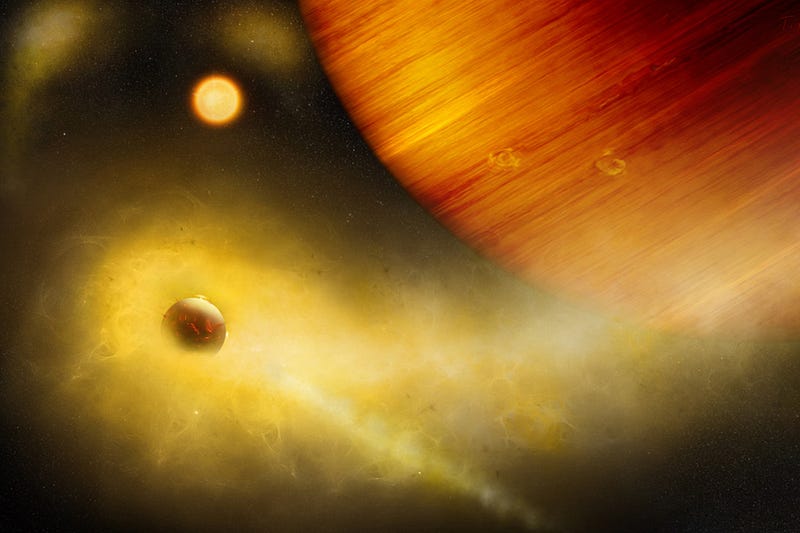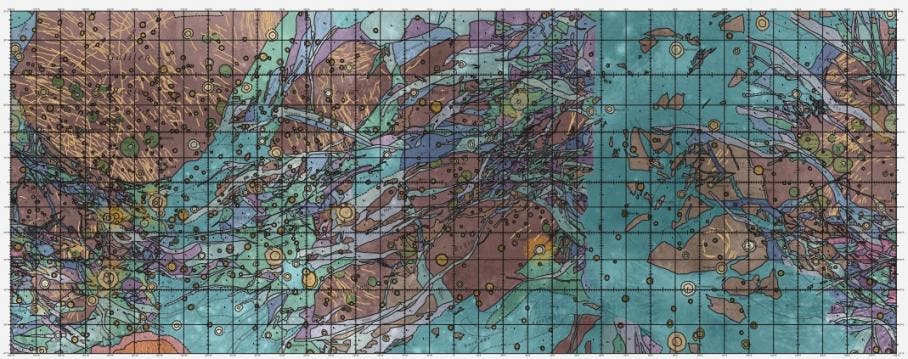
A rocky extrasolar moon brimming with lava could orbit a planet 550 light-years from Earth, astronomers led by researchers from Bern University have discovered.
The volcanically active exomoon could be hidden in the exoplanet system WASP-49b, orbiting a hot giant planet in the inconspicuous constellation of Lepus, underneath the bright Orion constellation.
The researchers describe the exomoon as an ‘extreme’ version of Jupiter’s moon Io — the most volcanically active body in our own solar system. Thus, painting a picture of an exotic and dangerous world — an ‘exo-Io’.
Apurva Oza, a postdoctoral fellow at the Physics Insitute of the University of Bern and associate of the NCCR PlanetS, describes the exomoon, comparing it to a famous sci-fi setting: “It would be a dangerous volcanic world with a molten surface of lava — a lunar version of close-in Super-Earths like 55 Cancri-e.
“A place where Jedis go to die, perilously familiar to Anakin Skywalker.”
More than a grain of sodium. Uniting theory and circumstantial evidence.
Astronomers have yet to discover a moon beyond our solar system meaning that the researchers base their suspicions of the existence of this exo-Io on circumstantial evidence — namely sodium gas in WASP-49b at an unusually high-altitude.
Oza explains: “The neutral sodium gas is so far away from the planet that it is unlikely to be emitted solely by a planetary wind.
“The sodium is right where it should be.”
Comparing this feature to observations of the Jupiter and Io system using low-mass calculations demonstrated to the team that an exo-Io could, indeed, be a plausible mechanism for sodium at WASP-49b.
The theory that large amounts of sodium around an exoplanet could point to a hidden moon or a ring of material was advance by Bob Johnson and Patrick Huggins in 2006. Following this, researchers from the University of Virginia calculated that a three-body system comprised of a star, close giant planet and a moon could remain stable for billions of years.
Oza took these theoretical predictions to form the basis of he and his colleagues’ work — published in the Astrophysical Journal.
The astrophysicist explains: “The enormous tidal forces in such a system are the key to everything.
“The energy released by the tides to the planet and its moon keeps the moon’s orbit stable, simultaneously heating it up and making it volcanically active.”
The researchers also demonstrate in their study that a small rocky moon would eject more sodium and potassium into space via this extreme volcanism than a large gas planet. This would especially be the case at high altitudes.
These emissions can then be identified by astronomers using the technique of spectroscopy. These particular elements are particularly useful to astronomers.
Oza adds: “Sodium and potassium lines are quantum treasures to us astronomers because they are extremely bright.
“The vintage street lamps that light up our streets with yellow haze, is akin to the gas we are now detecting in the spectra of a dozen exoplanets.”
When comparing their calculations with actual observations of sodium and potassium, the team found five candidate systems where a hidden exomoon could survive thermal evaporation. In the case of WASP-49b, the best explanation for the observed data was the presence of an exo-Io.
This isn’t the only explanation, however. As mention above, the observations of sodium at high altitudes could instead indicate the exoplanet is surrounded by a ring of material — most likely ionised gas.
Oza admits that the team need to find more clues, and as such, are relying on future observations with both ground and space-based telescopes. Also, as a few of these exo-Ios could eventually be destroyed as a result of extreme mass-loss, the team also want to search for evidence of such destruction.
Oza concludes: “While the current wave of research is going towards habitability and biosignatures, our signature is a signature of destruction.
“The exciting part is that we can monitor these destructive processes in real-time, like fireworks.”
Original research: https://arxiv.org/pdf/1908.10732.pdf






